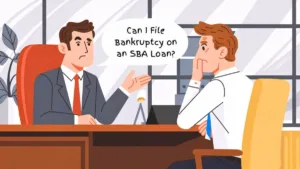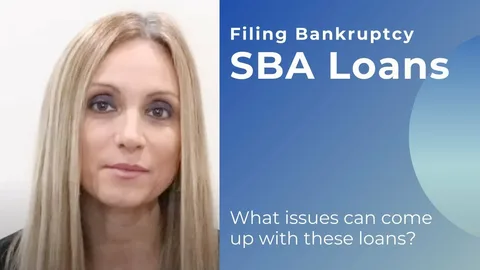An SBA loan is a type of loan provided by private lenders but guaranteed by the U.S. Small Business Administration (SBA). These loans are designed to help small businesses access financing that might otherwise be difficult to obtain from traditional lending sources.
The SBA does not directly lend money to small businesses. Instead, it partners with approved lenders, such as banks, credit unions, and other financial institutions, to provide loan guarantees. This guarantee reduces the risk for lenders, making them more willing to extend loans to small businesses.
To be eligible for an SBA loan, a business must meet certain criteria set by the SBA. Generally, the business must be considered a small business based on industry-specific size standards, operate for profit, and have reasonable owner equity to invest. Additionally, the business must demonstrate a need for the loan and the ability to repay it.
There are several types of SBA loans available, each designed to meet different business needs:
7(a) Loan Program: This is the SBA’s most popular loan program, offering a variety of loan types for various purposes, such as working capital, equipment purchases, real estate acquisition, and more.
504 Loan Program: This program provides long-term, fixed-rate financing for major fixed assets, such as land, buildings, machinery, and equipment.
Microloans: These are small loans, typically up to $50,000, designed for startups, newly established businesses, and small businesses with limited access to traditional financing.
Disaster Loans: These loans are available to businesses and homeowners affected by declared disasters, providing funds for repair, rebuilding, or economic recovery.
By understanding the definition, eligibility requirements, and types of SBA loans, small business owners can explore financing options that may be suitable for their specific needs.
Reasons for Filing Bankruptcy on an SBA Loan
Businesses may find themselves in a situation where filing for bankruptcy becomes a necessary step, even if they have an SBA loan. Some common reasons that lead to this decision include:
Cash Flow Issues: Insufficient cash flow is one of the primary reasons businesses struggle financially. When expenses consistently outpace revenue, it becomes increasingly difficult to meet financial obligations, such as loan payments, payroll, and operating costs.
Pandemic Impacts: The COVID-19 pandemic has had a devastating effect on many businesses, forcing them to temporarily close or operate at reduced capacity. This disruption in operations, combined with decreased consumer spending, has led to significant financial strain for numerous companies.
Economic Downturns: During periods of economic recession or downturn, businesses often experience a decrease in demand for their products or services. This can result in reduced sales and revenue, making it challenging to maintain profitability and meet financial obligations.
Overexpansion: Some businesses may have overextended themselves by expanding too quickly or taking on too much debt. This can lead to unsustainable financial burdens, particularly if the anticipated growth or revenue fails to materialize.
Mismanagement: Poor management decisions, such as inadequate financial planning, excessive spending, or inefficient operations, can contribute to a company’s financial distress and eventual bankruptcy.
Increased Competition: Intense competition in the market can erode a business’s customer base and market share, leading to a decline in revenue and profitability.
Warning Signs of Financial Distress: Businesses should be vigilant for warning signs that may indicate impending financial trouble, such as consistently missing loan payments, defaulting on debts, declining sales or profits, inability to pay suppliers or employees, and legal disputes or judgments against the company.
Recognizing these reasons and warning signs early on can help businesses take proactive steps to address their financial challenges and potentially avoid bankruptcy.
Options Besides Bankruptcy

Before considering bankruptcy for your SBA loan, it’s essential to explore alternative options that could potentially help you avoid this drastic measure. Here are some alternatives to consider:
Debt Restructuring: Approach your lender and negotiate a debt restructuring plan. This could involve extending the loan term, reducing interest rates, or modifying payment schedules to make them more manageable for your business.
Selling Assets: If your business has valuable assets, consider selling them to generate funds to pay off a portion or all of the SBA loan. This could include equipment, inventory, real estate, or other assets that are not essential for your core operations.
Finding Investors: Seek out potential investors who may be willing to inject capital into your business in exchange for equity. This influx of funds could help you pay off the SBA loan and provide additional working capital to get your business back on track.
Downsizing Operations: Evaluate your business operations and identify areas where you can cut costs and streamline expenses. This could involve reducing staff, renegotiating leases, or scaling back non-essential services or product lines.
Debt Consolidation: If you have multiple debts, consider consolidating them into a single loan with a lower interest rate and more favorable terms. This can simplify your repayment process and potentially reduce your overall debt burden.
It’s important to note that these alternatives may not be suitable for every situation, and their effectiveness will depend on your specific circumstances. Consulting with a financial advisor or attorney can help you evaluate the best course of action for your business.
Types of Bankruptcy for Businesses
There are two main types of bankruptcy that businesses can file for when dealing with an SBA loan – Chapter 7 liquidation and Chapter 11 reorganization.
Chapter 7 Bankruptcy
Chapter 7 bankruptcy, also known as straight bankruptcy or liquidation bankruptcy, involves the sale of a company’s non-exempt assets to pay off creditors. This type of bankruptcy is generally suitable for businesses that are no longer viable and cannot realistically restructure their debts.
Pros:
- Provides a fresh start by discharging most unsecured debts
- Relatively quick process, usually completed within a few months
- Creditors can no longer pursue the business for discharged debts
Cons:
- The business must cease operations and liquidate assets
- Secured creditors can still seize collateral for unpaid loans
- Potential loss of personal assets for sole proprietors or partners
Chapter 11 Bankruptcy
Chapter 11 bankruptcy, also known as reorganization bankruptcy, allows a business to restructure its debts while continuing operations. This type of bankruptcy is typically used by larger companies or those with a viable future.
Pros:
- The business can continue operating and restructure its debts
- Opportunity to negotiate more favorable repayment terms with creditors
- Automatic stay protects the company from creditor actions during reorganization
Cons:
- Complex and expensive process, requiring significant legal and professional fees
- Strict oversight and reporting requirements by the bankruptcy court
- Potential loss of control or ownership interests in the company
The choice between Chapter 7 and Chapter 11 bankruptcy depends on the specific circumstances of the business, its financial situation, and its prospects for future viability. It’s crucial to seek professional legal advice to understand the implications and determine the most appropriate course of action.
Steps to File Bankruptcy on an SBA Loan
Filing bankruptcy on an SBA loan involves a multi-step legal process that requires careful preparation and adherence to court procedures. Here are the typical steps to file bankruptcy on an SBA loan:
Gather Financial Documents: Collect all relevant financial records, including bank statements, tax returns, loan documents, asset listings, and a comprehensive list of creditors and outstanding debts. These documents will be necessary for filing the bankruptcy petition and accompanying schedules.
Determine the Appropriate Bankruptcy Chapter: Businesses typically file under Chapter 7 (liquidation) or Chapter 11 (reorganization). Evaluate your financial situation, future prospects, and goals to determine the suitable bankruptcy chapter for your case.
Take Credit Counseling: Before filing, you must complete a credit counseling course from an approved agency within 180 days. This course educates you on debt management alternatives and the bankruptcy process.
File the Bankruptcy Petition: With the assistance of a bankruptcy attorney, prepare and file the official bankruptcy petition, along with the required schedules and statements, at the appropriate bankruptcy court. This initiates the legal bankruptcy process.
Pay Filing Fees: Bankruptcy filing fees must be paid to the court upon submission of the petition. These fees vary based on the bankruptcy chapter and can be waived in cases of financial hardship.
It’s crucial to work closely with an experienced bankruptcy attorney throughout the process to ensure compliance with all legal requirements and to protect your rights as a debtor. Additionally, bankruptcy courts may have specific local rules or procedures that must be followed.
Impact on Personal Finances and Credit
Filing for bankruptcy on an SBA loan can have significant consequences on an individual’s personal finances and credit. Even though the loan was taken out for business purposes, the personal guarantee required by the SBA means that the borrower’s personal assets may be at risk.
When a business files for bankruptcy, the owner’s personal credit score will take a major hit. A bankruptcy filing remains on an individual’s credit report for 7-10 years, making it difficult to obtain new credit or loans during that time. Additionally, the borrower may face challenges in securing employment, renting an apartment, or even getting utilities turned on due to the negative credit impact.
In a Chapter 7 bankruptcy, the borrower’s non-exempt assets, including personal property such as a house, car, or investments, could be seized to repay creditors. However, certain assets may be protected depending on state exemption laws. In a Chapter 13 bankruptcy, the borrower must commit to a court-approved repayment plan using disposable income, which could significantly impact their personal finances for several years.
It’s crucial to consider the potential impact on personal income as well. If the business was the primary source of income, the borrower may need to find alternative employment or income sources after filing for bankruptcy. This could lead to a temporary or permanent reduction in household income, affecting the individual’s ability to meet personal financial obligations.
Life After Bankruptcy for a Business
Filing for bankruptcy can feel like a major setback, but it’s also an opportunity for a fresh start. While the bankruptcy will remain on your credit report for several years, there are steps you can take to rebuild your credit and financial standing.
Rebuilding Credit: After bankruptcy, focus on paying all bills on time, keeping debt levels low, and monitoring your credit reports for accuracy. Consider a secured credit card to help reestablish a positive payment history. Over time, as you demonstrate responsible financial behavior, your credit scores will improve.
Starting a New Business: Bankruptcy doesn’t prevent you from starting a new business venture. However, you may face challenges securing financing from traditional lenders in the first few years. Explore alternative funding options like crowdfunding, angel investors, or personal loans from friends and family. Prove your commitment to the new business by investing your own money upfront.
Effects on Future Lending: Bankruptcy makes it more difficult to obtain loans and lines of credit, at least initially. Lenders will scrutinize your application more closely and may require higher down payments, collateral, or cosigners. Be prepared to pay higher interest rates as well. Maintain open communication with lenders, explain what led to the bankruptcy, and demonstrate how your financial situation has improved.
While bankruptcy has its drawbacks, it can ultimately lead to a stronger, more sustainable business model. With discipline, hard work, and a solid plan, you can regain your financial footing and position yourself for long-term success.
Finding Legal Assistance
Filing for bankruptcy on an SBA loan is a complex legal process with significant consequences for your business and personal finances. It’s crucial to seek guidance from an experienced bankruptcy attorney who can evaluate your unique situation and advise you on the best course of action.
An attorney specializing in bankruptcy law can help you navigate the intricate legal procedures, ensure you comply with all filing requirements, and protect your rights throughout the process. They can also negotiate with creditors on your behalf, represent you in court, and maximize the chances of a favorable outcome.
While hiring a bankruptcy attorney may seem like an added expense, their expertise can save you time, money, and stress in the long run. They can help you avoid costly mistakes and ensure that your bankruptcy case is handled efficiently and effectively.
If you’re concerned about the cost of legal representation, there are resources available to help you find affordable legal assistance. Many law firms offer free initial consultations, and some attorneys may be willing to work on a contingency or flat-fee basis. Additionally, legal aid organizations and pro bono services can provide low-cost or free legal assistance to those who qualify based on their income and assets.
When selecting a bankruptcy attorney, consider their experience, credentials, and track record of success in handling cases similar to yours. Ask for referrals from trusted sources, read online reviews, and schedule consultations with multiple attorneys to find the best fit for your needs.
Bankruptcy Alternatives for SBA Loans
While bankruptcy may seem like the only option when facing overwhelming debt from an SBA loan, there are alternatives worth exploring before taking that drastic step. One potential solution is to negotiate a workout agreement with the SBA, which could involve restructuring the loan terms, extending the repayment period, or even temporarily suspending payments. This approach can provide much-needed breathing room and potentially avoid the long-lasting consequences of bankruptcy.
Another option is to negotiate directly with other creditors, exploring possibilities such as debt settlement or consolidation. By working proactively with creditors, you may be able to reach more favorable repayment arrangements that allow you to gradually pay off your debts without the need for bankruptcy.
Additionally, the SBA offers various loan forgiveness programs that could potentially provide relief for borrowers facing financial hardship. These programs are designed to assist small businesses in overcoming challenges and getting back on their feet. Exploring eligibility requirements and applying for loan forgiveness could be a viable alternative to bankruptcy, allowing you to preserve your credit and avoid the stigma associated with bankruptcy.
It’s important to note that these alternatives may not be suitable for every situation, and their effectiveness can depend on various factors, including the specific circumstances of your business and the willingness of creditors to negotiate. However, exploring these options before resorting to bankruptcy can be a valuable exercise, as it may provide a path forward without the severe consequences that bankruptcy can bring.
Case Studies and Examples
Toy Company in Ohio
A small toy manufacturing company in Ohio had taken out an SBA loan of $500,000 to expand their operations and purchase new equipment. However, due to increased competition from larger retailers and a shift in consumer preferences, the company struggled to generate enough revenue to repay the loan. After exhausting all other options, the owners decided to file for Chapter 11 bankruptcy protection. Through the bankruptcy process, they were able to restructure their debt, renegotiate contracts with suppliers, and eventually emerge as a leaner, more focused business. Although the process was challenging, the company was able to continue operations and eventually regain profitability.
Restaurant Chain in Florida
A popular restaurant chain in Florida had used SBA loans to finance the opening of several new locations. However, when the COVID-19 pandemic hit, the company was forced to close its doors for an extended period, leading to a significant loss of revenue. Despite efforts to obtain additional financing and negotiate with creditors, the company ultimately filed for Chapter 7 bankruptcy. The SBA loans were discharged through the bankruptcy process, and the company was forced to liquidate its assets to pay off creditors. While the business itself did not survive, the owners were able to start fresh and potentially explore new entrepreneurial ventures in the future.

